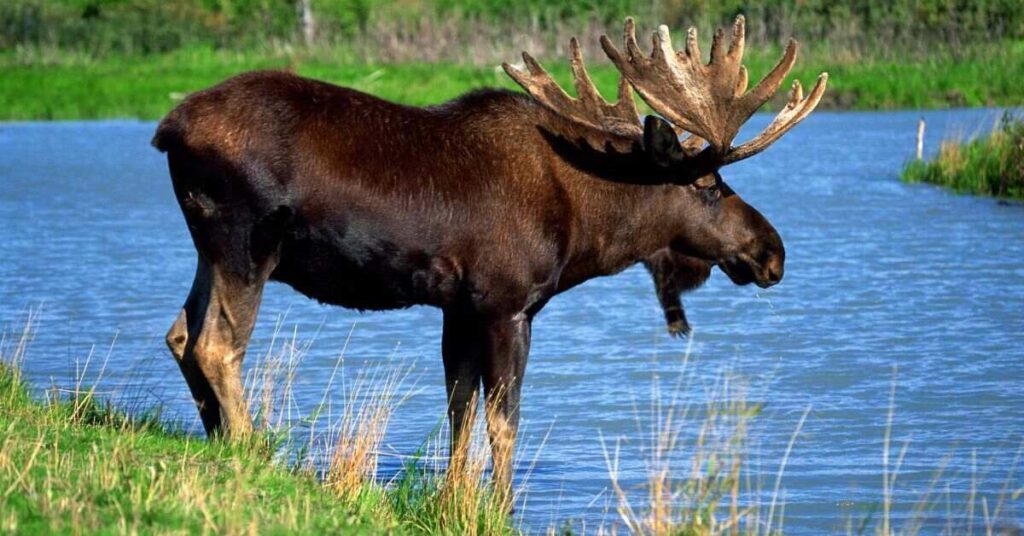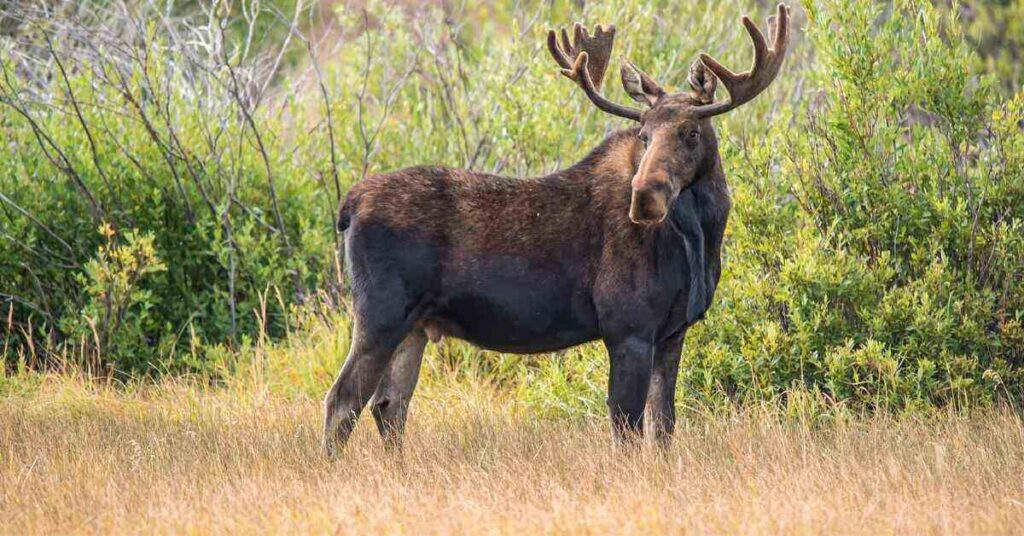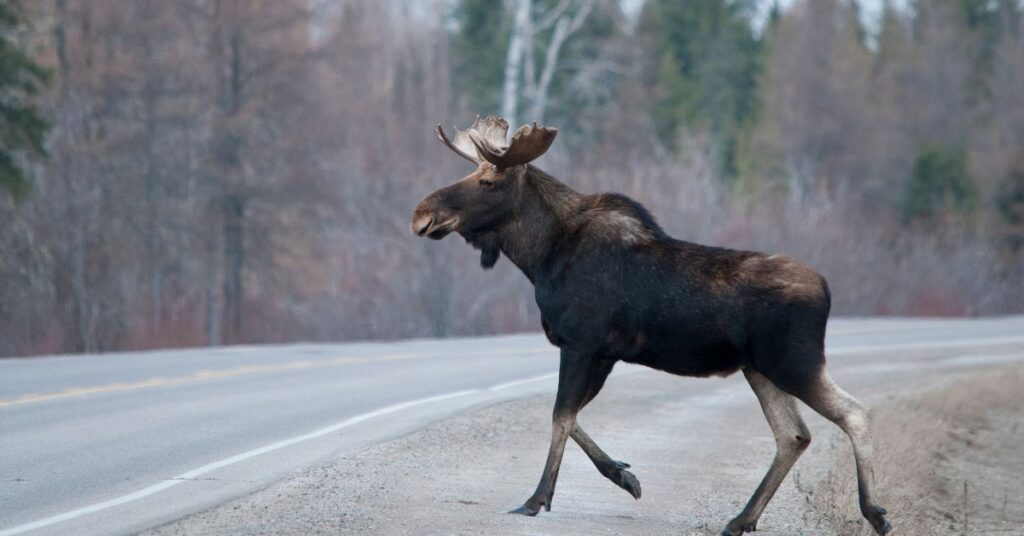When hiking in the untamed wilderness, one encounter you may face is a moose attack. These majestic creatures may seem harmless, but when provoked, they can unleash their fury upon you. But fear not, for you hold the power to survive and overcome this challenge.
React calmly and slowly, find cover or an escape route, and utilize deterrents effectively to protect yourself if need be. Remember to seek help and report the incident, and most importantly, learn from the experience for future encounters.
Read on to discover what you need to do to survive a moose attack.
Understanding Moose Behavior
If you ever find yourself face to face with a moose when hiking, you need to understand their behavior and, in a split second, decide whether to fight or flee.
Moose are generally peaceful creatures, but they can become aggressive if they feel threatened or provoked. One important thing to remember is to never approach a moose too closely, as they have a natural personal space that they will defend.

If you encounter a moose, give it plenty of space and try to move away slowly and quietly. Avoid making sudden movements or loud noises that could startle the moose.
If the moose charges at you, your best bet is to find shelter behind a tree or a large object. Understanding moose behavior can greatly increase your chances of surviving a moose encounter.
Identifying Signs of Aggression
Recognizing the telltale signs of a moose’s aggression is crucial for your safety. It’s essential to be aware of their body language and behavior to determine if they are becoming aggressive. Here are some signs to look out for:
- Physical signs: Moose may display aggressive behaviors such as lowering their head, raising their hackles, or stomping their hooves. These physical manifestations indicate their readiness to attack.
- Body posture: A moose in an aggressive state will hold its head up high, with ears laid back and hair raised on its neck.
- Vocalizations: Listen for loud grunts, snorts, or huffing sounds, as these can indicate the moose’s aggression.
By recognizing these signs, you can take necessary precautions to avoid a moose attack and ensure your safety while trekking.
Maintaining a Safe Distance
To ensure your well-being, it’s crucial that you keep a safe distance from a moose, lest you find yourself in an unplanned dance routine with their hooves.
Keep at least 50 feet between you and the moose, giving them enough space to feel comfortable and ensuring you have time to react if they charge. Avoid getting too close to take pictures or approach their calves, as this may provoke them.
Reacting Calmly and Slowly
When encountering a moose, react calmly and slowly, ensuring you don’t startle or provoke the majestic creature. The key is to remain composed and avoid any sudden movements that might agitate the moose.
Keep your voice low and soothing, speaking in a gentle tone to reassure the moose that you mean no harm. Remember, the moose is likely just as scared as you are, so showing respect and empathy is crucial.
Slowly back away from the moose, but avoid turning your back on it, as sudden movements may trigger its instinct to chase. Staying calm and composed increases your chances of safely navigating a moose encounter.
Finding Cover or an Escape Route
Take a moment to identify a safe place or a potential way to quickly move to safety if you find yourself in a difficult situation with a moose.
Look around you and assess your surroundings. Is there a large tree, a rock formation, or a sturdy building nearby that can provide protection? Make sure the cover is solid and can withstand the force of a charging moose.
If there is no immediate cover, look for an escape route. Is there a clear path to run away from the moose? Avoid obstacles and choose a direction that leads to safety.

Using Deterrents Effectively
Now that you’ve found cover or an escape route, let’s talk about using deterrents effectively to increase your chances of survival during a moose attack.
One effective deterrent is using bear spray, which can disorient the moose and give you a chance to escape. Keep the spray easily accessible, preferably on a hip holster, and practice using it beforehand so you’re prepared in the heat of the moment.
Another useful tool is noise. Make loud noises by yelling, clapping, or using an air horn to startle the moose and hopefully deter them from approaching.
If you have a firearm, aim for the moose’s vital organs, but only as a last resort to protect your life.
Related: How to Avoid Snakes While Hiking
Seeking Help and Reporting the Incident
Seek immediate assistance and report the incident to ensure proper measures are taken to address the situation. Contact emergency services or park rangers who can provide guidance and support.
While waiting for help to arrive, stay calm and avoid any sudden movements that may provoke the moose further. Reporting the incident is also crucial for the authorities to gather information about moose activity in the area and take appropriate actions to prevent future encounters.
By reporting the incident, you contribute to the well-being and safety of not only yourself but also others who may encounter moose in the future.
At What Times of the Year Are Moose Dangerous?
Moose can be more dangerous during certain times of the year, particularly during their mating and calving seasons.
- Mating Season (Rut): In the fall, typically from September to October, moose enter their mating season, also known as the rut. During this time, male moose (bulls) become more aggressive and territorial as they compete for mates. They may be less predictable and may perceive humans as potential threats. Exercise caution and keep a safe distance during the rut.
- Calving Season: In the spring, usually from May to June, female moose (cows) give birth to their calves. Mother moose are highly protective during this period and can become aggressive if they perceive any potential threat to their young. It’s essential to be extra cautious and avoid getting too close to cow moose with calves.
While moose can be unpredictable throughout the year, being aware of their behavioral patterns during these specific seasons can help you take appropriate precautions.
Related: How to Avoid Mountain Lions in the Wild

Key Takeaways
– Recognize signs of aggression in moose behavior.
– Maintain a safe distance and react calmly.
– Find shelter and identify escape routes.
– Use deterrents and seek assistance.
Surviving a moose attack requires knowledge, quick thinking, and a calm demeanor. We hope the above tips will help you survive a moose attack. Stay safe and be as agile as a cat in the wilderness!
Frequently Asked Questions (FAQs)
Does bear spray work on moose?
Bear spray can be effective on moose. Though it’s primarily designed for bears, the spray’s active ingredients can also deter moose if used correctly. However, it’s essential to exercise caution and follow safety guidelines when encountering moose in the wild.
Are moose friendly?
Moose are wild animals and generally not considered friendly. While they usually prefer to avoid human interactions, they can become aggressive if they feel threatened or cornered. Maintain a safe distance and respect their space when encountering moose in the wild.
Are moose aggressive?
Moose can be aggressive, especially during certain times of the year, such as their mating season (rut) and calving season. They may perceive humans as threats and can react defensively if they feel cornered or provoked.
How do you scare a moose away?
To scare a moose away, make yourself look larger by raising your arms or holding out a jacket. Yell loudly and stomp your feet to create noise. Back away slowly without turning your back on the moose, allowing it an escape route.
Do moose eat people?
Moose do not eat people. They are herbivores and primarily consume plants like leaves, twigs, and aquatic vegetation. However, moose can be unpredictable and potentially dangerous if they feel threatened, so keep a safe distance when encountering them in the wild.
How powerful are moose?
Moose are incredibly powerful animals, with adult males (bulls) weighing up to 1,500 pounds or more. Their strength lies in their muscular build and large antlers, which they use for defence and dominance during mating season. If you encounter one in the wild, avoid getting too close to it.
How common are moose attacks in Alaska?
Moose attacks in Alaska are relatively rare, with an average of five to ten incidents reported per year. However, it’s crucial to exercise caution, as moose encounters can happen in both urban areas and wilderness.
